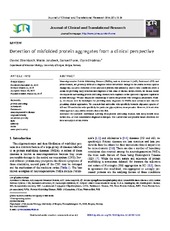Detection of misfolded protein aggregates from a clinical perspective
Peer reviewed, Journal article
Published version

Åpne
Permanent lenke
https://hdl.handle.net/1956/22963Utgivelsesdato
2016Metadata
Vis full innførselSamlinger
Originalversjon
https://doi.org/10.18053/jctres.02.201601.003Sammendrag
Neurodegenerative Protein Misfolding Diseases (PMDs), such as Alzheimer’s (AD), Parkinson’s (PD) and prion diseases, are generally difficult to diagnose before irreversible damage to the central nervous system damage has occurred. Detection of the misfolded proteins that ultimately lead to these conditions offers a means for providing early detection and diagnosis of this class of disease. In this review, we discuss recent developments surrounding protein misfolding diseases with emphasis on the cytotoxic oligomers implicated in their aetiology. We also discuss the relationship of misfolded proteins with biological membranes. Finally, we discuss how far techniques for providing early diagnoses for PMDs have advanced and describe promising clinical approaches. We conclude that antibodies with specificity towards oligomeric species of AD and PD and lectins with specificity for particular glycosylation, show promise. However, it is not clear which approach may yield a reliable clinical test first. Relevance for patients: Individuals suffering from protein misfolding diseases will likely benefit form earlier, less- or even non-invasive diagnosis techniques. The current state and possible future directions for these are subject of this review.
